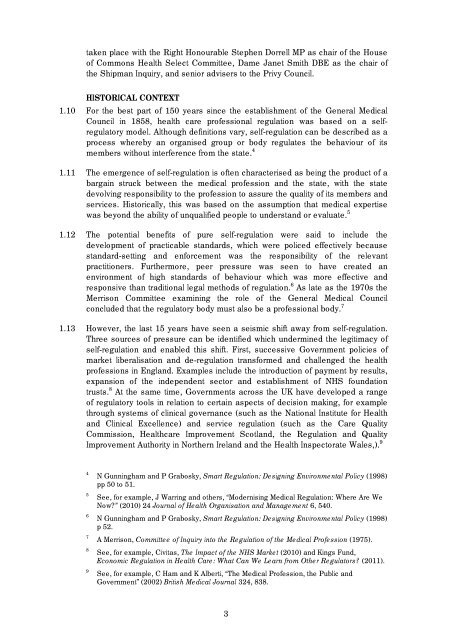Regulation of Health and Social Care Professionals Consultation
Regulation of Health and Social Care Professionals Consultation
Regulation of Health and Social Care Professionals Consultation
You also want an ePaper? Increase the reach of your titles
YUMPU automatically turns print PDFs into web optimized ePapers that Google loves.
taken place with the Right Honourable Stephen Dorrell MP as chair <strong>of</strong> the House<br />
<strong>of</strong> Commons <strong>Health</strong> Select Committee, Dame Janet Smith DBE as the chair <strong>of</strong><br />
the Shipman Inquiry, <strong>and</strong> senior advisers to the Privy Council.<br />
HISTORICAL CONTEXT<br />
1.10 For the best part <strong>of</strong> 150 years since the establishment <strong>of</strong> the General Medical<br />
Council in 1858, health care pr<strong>of</strong>essional regulation was based on a selfregulatory<br />
model. Although definitions vary, self-regulation can be described as a<br />
process whereby an organised group or body regulates the behaviour <strong>of</strong> its<br />
members without interference from the state. 4<br />
1.11 The emergence <strong>of</strong> self-regulation is <strong>of</strong>ten characterised as being the product <strong>of</strong> a<br />
bargain struck between the medical pr<strong>of</strong>ession <strong>and</strong> the state, with the state<br />
devolving responsibility to the pr<strong>of</strong>ession to assure the quality <strong>of</strong> its members <strong>and</strong><br />
services. Historically, this was based on the assumption that medical expertise<br />
was beyond the ability <strong>of</strong> unqualified people to underst<strong>and</strong> or evaluate. 5<br />
1.12 The potential benefits <strong>of</strong> pure self-regulation were said to include the<br />
development <strong>of</strong> practicable st<strong>and</strong>ards, which were policed effectively because<br />
st<strong>and</strong>ard-setting <strong>and</strong> enforcement was the responsibility <strong>of</strong> the relevant<br />
practitioners. Furthermore, peer pressure was seen to have created an<br />
environment <strong>of</strong> high st<strong>and</strong>ards <strong>of</strong> behaviour which was more effective <strong>and</strong><br />
responsive than traditional legal methods <strong>of</strong> regulation. 6 As late as the 1970s the<br />
Merrison Committee examining the role <strong>of</strong> the General Medical Council<br />
concluded that the regulatory body must also be a pr<strong>of</strong>essional body. 7<br />
1.13 However, the last 15 years have seen a seismic shift away from self-regulation.<br />
Three sources <strong>of</strong> pressure can be identified which undermined the legitimacy <strong>of</strong><br />
self-regulation <strong>and</strong> enabled this shift. First, successive Government policies <strong>of</strong><br />
market liberalisation <strong>and</strong> de-regulation transformed <strong>and</strong> challenged the health<br />
pr<strong>of</strong>essions in Engl<strong>and</strong>. Examples include the introduction <strong>of</strong> payment by results,<br />
expansion <strong>of</strong> the independent sector <strong>and</strong> establishment <strong>of</strong> NHS foundation<br />
trusts. 8 At the same time, Governments across the UK have developed a range<br />
<strong>of</strong> regulatory tools in relation to certain aspects <strong>of</strong> decision making, for example<br />
through systems <strong>of</strong> clinical governance (such as the National Institute for <strong>Health</strong><br />
<strong>and</strong> Clinical Excellence) <strong>and</strong> service regulation (such as the <strong>Care</strong> Quality<br />
Commission, <strong>Health</strong>care Improvement Scotl<strong>and</strong>, the <strong>Regulation</strong> <strong>and</strong> Quality<br />
Improvement Authority in Northern Irel<strong>and</strong> <strong>and</strong> the <strong>Health</strong> Inspectorate Wales,). 9<br />
4<br />
N Gunningham <strong>and</strong> P Grabosky, Smart <strong>Regulation</strong>: Designing Environmental Policy (1998)<br />
pp 50 to 51.<br />
5 See, for example, J Warring <strong>and</strong> others, “Modernising Medical <strong>Regulation</strong>: Where Are We<br />
Now?” (2010) 24 Journal <strong>of</strong> <strong>Health</strong> Organisation <strong>and</strong> Management 6, 540.<br />
6<br />
N Gunningham <strong>and</strong> P Grabosky, Smart <strong>Regulation</strong>: Designing Environmental Policy (1998)<br />
p 52.<br />
7 A Merrison, Committee <strong>of</strong> Inquiry into the <strong>Regulation</strong> <strong>of</strong> the Medical Pr<strong>of</strong>ession (1975).<br />
8 See, for example, Civitas, The Impact <strong>of</strong> the NHS Market (2010) <strong>and</strong> Kings Fund,<br />
Economic <strong>Regulation</strong> in <strong>Health</strong> <strong>Care</strong>: What Can We Learn from Other Regulators? (2011).<br />
9 See, for example, C Ham <strong>and</strong> K Alberti, “The Medical Pr<strong>of</strong>ession, the Public <strong>and</strong><br />
Government” (2002) British Medical Journal 324, 838.<br />
3
















